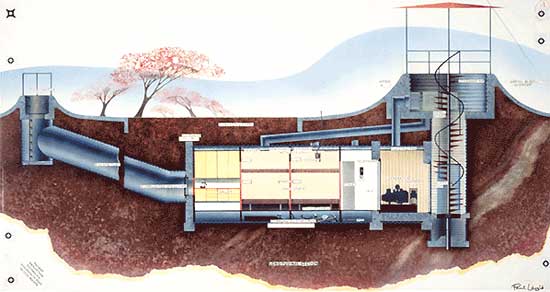Underground
Homes as Emergency Shelters
Emergency shelters were mainly thought of in terms of
nuclear attack during the Cold War. More recently, with
months of bizarre weather, orders for tornado shelters
are booming.
|
|
 Underground home used as an emergency
shelter
Underground home used as an emergency
shelter |
But if you live in an underground home, you have an emergency
shelter right there - and it's not cramped, cold or dark
like smaller shelters can often be.
Many earth-sheltered houses are made with self-sustainability
built-in. Some are even off the electricity grid, which
makes them very habitable even after events that disrupt
the power supply. If you have the provisions, and stock
up when you shop, you can easily keep a stock of food
that would last a substantial length of time, if it needed
to.
Underground houses have been designed and engineered
to last many years, with very limited maintenance. Reinforced
concrete as used in earth-sheltered homes is very protective,
and you might even explore the option of adding a safer
layer beneath your underground home, for emergencies.
Gimme Shelter ...
Years of successful research go into every earth-sheltered
home, and each one is made with your design specifications
in mind. If you wish to employ your house also as a shelter,
or add a shelter area below it, these can be incorporated
into your building plans.

Underground Home Shelter
If you place your home at a significant depth, it will
be more resistant even to nuclear attack. If fact, some
abandoned missile
silos have been sold to civilians who in turn repurpose
them as safe and secure underground homes.
Some companies build homes that are also bomb shelters,
using earth itself as a buffer between you and the outside
world. Any buildings along surface level could be destroyed
by a blast close-by, but you would be protected if you
use the subterranean rooms of your house, which are hundreds
of feet below the surface.
Primary and Secondary ...
The length of time you spend below your primary residence
after any type of disaster depends on you and your plan.
These deep shelters have room for you, your family and
your pets. Full-sized homes of 1500-3000 square feet can
also be built deep underground, so they would serve as
your primary residence as well as your emergency shelter.
There is good reason to incorporate the option of taking
shelter in your underground home in the case of an emergency.
Some shelters themselves are thought to be bomb-proof,
but the bunkers that are being
produced now in that category are in no way suited for
everyday life. These shelters sometimes include stockpiles
of food and other essentials, but they are not of a type
that can be lived in on an everyday basis, like an earth-sheltered
home.

Underground Shelter
The underground homes you might tour today show you that
living underground can still allow for a well-lit and
nicely appointed home. Homes including bunkers or that
could be used as shelters for bombs, tornadoes or chemical
attacks are a more comfortable and likely way to live
during times of unrest or violent weather.
Some houses that serve as shelters have reinforced roofs
and earthen or concrete walls. The living space could
include a greenhouse or a courtyard, which would help
bring light into the home. Rainwater collection, with
drilled wells or rain gutters, will supply clean water
to homes, as long as no chemical threats are present.
Solar panels can gather energy from the sun, and then
have an option to be sealed with steel panel covers if
trouble is expected.
Conclusion ...
Many specialized features are included in underground
homes that are designed to be used as shelters as well.
Of course, extra fortification may be desired by some,
especially Preppers.
Written by Kevin Knatloa
First Published on November 05, 2012
Updated November 22, 2013
External Links - References
http://www.home-designing.com/2009/10/bomb-shelter-house-designs
http://www.delagostti-industries.com/bombshelters.html
http://www.tinyhousedesign.com/2012/03/16/small-underground-house-shelter/
|